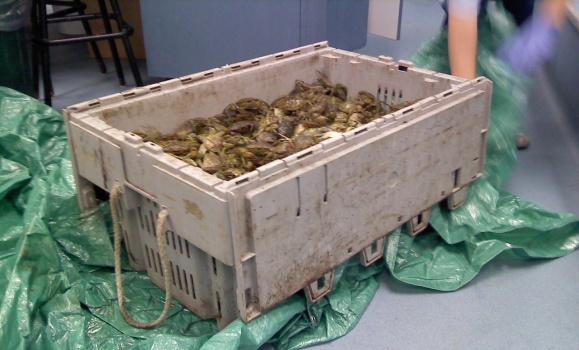Media Releases
» Go to news mainDal research suggests green crab is risky bait for lobster industry

BIBLE HILL, N.S. – February 23, 2015 – Recent research conducted by Dalhousie University’s Faculty of Agriculture indicates a high prevalence of a green crab pathogen now being found in lobsters in some Atlantic Canadian locations. The pathogen, a primary pathogen of green crab, correlates with increased use of green crabs as lobster bait over the last several years.
“Studies have shown that in their native range, green crabs carry up to 13 different pathogens, several of which we know are also pathogens that can infect lobsters,” explained Dr. Sarah Stewart-Clark, Dalhousie University Faculty of Agriculture.
Hundreds of rural Atlantic Canadian communities rely on the lobster fishery for their survival. Low shore prices coupled with high fuel and bait costs are forcing fishers to seek out low cost alternative bait wherever they can.
The proliferation and spread of green crab populations has also been extensive in Atlantic Canada. This invasive crab has been devastating local populations of softshell clams and oysters and destroying ecologically crucial eel grass habitat. Fisher and government organizations, as well as local environmental groups, are seeking methods to remove green grabs from their bays and estuaries and sell their harvest to offset their costs.
These two issues have forced many fishers to look at using green crab as a low-cost alternative to traditional baits. There are already 75 green crab harvesting licenses issued in Southwestern N.S., where the majority of the harvest, up to 20,000 lbs/fisher, will be sold as lobster bait.
Atlantic Veterinary College (AVC) Lobster Science Centre scientist Dr. Fraser Clark and Dalhousie University’s Dr. Stewart-Clark initiated this research project in the spring of 2014 at the Faculty of Agriculture, Dalhousie Agricultural Campus, to determine if there was potential for green crabs to carry pathogens that could be spread to lobsters when green crabs are used as bait.
Their research is also investigating whether bacterial and viral pathogens are being spread from green crabs to lobsters. Lobster fishers and policy makers need this information before they use or sanction widespread use of green crabs as lobster bait.
Their recent findings indicate there is a high prevalence of a green crab pathogen now being found in lobsters in some Atlantic Canadian locations.
“This pathogen has no effect on humans, does not survive cooking or freezing and does not affect the taste of lobster meat, added Dr. Clark. “It may however, affect lobster behavior and make them more susceptible to predators, or affect their ability to maintain their high quality in live-holding,” he added.
The potential spread of bacterial, parasitic and viral pathogens from green crabs to lobsters, or other crustaceans, has the potential to cause widespread morbidity and mortality in both lobsters in the natural environment and in live-holding. The fact that a green crab parasite has been detected in lobsters demonstrates the potential that other bacterial, parasitic and viral lobster diseases may be spread between these two species.
The two researchers received funding from the Atlantic Lobster Sustainability Foundation to investigate the suitability of using green crabs as lobster bait. Based on early information, lobster and crabs from Nova Scotia are both infected with the P. botulus parasite and a cautious approach should be taken before the use of green crabs as lobster bait is widely promoted.
These research findings were presented last week, February 19that the Fishermen and Scientists Research Society Annual meeting in Dartmouth NS.
-30-
Media Contact
Stephanie Rogers
Communications Manager
Dalhousie University Faculty of Agriculture
(902) 893-7247 / s.rogers@dal.ca
Comments
comments powered by Disqus
Recent News
- Media release: Nova Scotia pharmacists among Canada’s first to prescribe HIV prevention drug with help from Dalhousie pilot study
- Media opportunity: What do you need to make a hit song? Math, according to a Dalhousie University mathematician who created a pop song using fractals, the cantor set and all things mathy
- Media opportunity: Uncovering the link between meltwater and groundwater in mountain regions is a priority for sustainable water management: international research paper
- Media opportunity: Fish biomass faces steep declines by end of century under high‑emissions scenario: FAO report by Dalhousie University, international scientists
- Media Release: Two Dalhousie students selected as McCall MacBain International Fellows
- Media release: Barriers to care ‑ research reveals the experiences of transgender and gender‑diverse people seeking health care
- Media opportunity: Being involved in extracurricular activities really does matter when it comes to 'mattering': Dalhousie University research
- Media opportunity: Podcast by Dalhousie researcher and Halifax photographer looks at barriers to Nova Scotia's coastline, decreasing access to waterfronts and problems with litter, marine debris in public coastal areas
